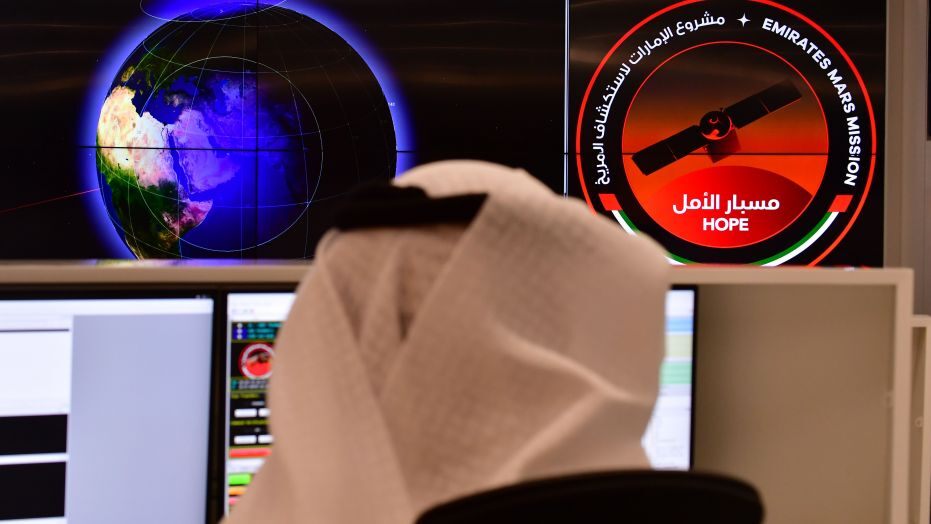The orbiter named Amal, or Hope, is the Arab world’s first interplanetary mission
The United Arab Emirates is set to launch a historic mission to Mars from an island off the coast of Japan.
The orbiter named Amal, or Hope, is the Arab world’s first interplanetary mission. Amal will take the UAE into an exclusive group of countries that have orbited Mars that includes the U.S., India and the former Soviet Union, as well as the European Space Agency. China will soon launch its own rover to the Red Planet.
“Two days separate us from the date of the next opportunity to launch the ‘Probe of Hope’ to the Red Planet, God willing. Arabs to Mars” tweeted Dr. Mohammed Alahbabi, director-general of the UAE Space Agency, on Friday.
يفصلنا يومان عن موعد الفرصة القادمة لإطلاق (مسبار الأمل) الى الكوكب الاحمر إن شاء الله. العرب الى المريخ. pic.twitter.com/p7kjMiY6Ng
— Dr.Mohammed AlAhbabi (@DrAlahbabi) July 17, 2020
The launch, initially scheduled for Wednesday from Japan’s Tanegashima Space Center, was postponed as a result of thunderstorms, clouds, and unstable weather conditions. The mission’s launch has been reset for 5:58 p.m. ET Sunday, a spokesman for the mission told Fox News Friday.
Hope’s mission control is the Mohammed Bin Rashid Space Centre in Dubai.
أعلنت وكالة الإمارات للفضاء ومركز محمد بن راشد للفضاء أنه تقرر مبدئياً أن يكون إطلاق مهمة الإمارات للمريخ في 20 يوليو 2020 الجاري في تمام الساعة 1:58 بعد منتصف الليل بتوقيت الإمارات.#العرب_إلى_المريخ pic.twitter.com/OBlEIQUup5
— MBR Space Centre (@MBRSpaceCentre) July 17, 2020
Mitsubishi Heavy Industries, which is the provider of the H-IIA rocket, said there is a slight chance of further postponement depending on the weather. The company has set a launch window through Aug. 13. A final decision is expected Sunday.
Hope is to reach Mars in February 2021, the year the UAE celebrates 50 years since its formation. A successful Hope mission would be a major step for the oil-dependent economy seeking a future in space.
Mars also looms large for a number of other countries, including China and the U.S., which will soon launch their own missions to the Red Planet.
NASA, for example, is getting ready to launch its Mars 2020 Perseverance rover on an epic mission to the Red Planet.
The launch window for the spacecraft that will carry the Perseverance rover to Mars opens on July 20 and closes on Aug 11, 2020.
Launched atop a United Launch Alliance Atlas V rocket from Cape Canaveral Air Force Station in Florida, the rover is scheduled to land on Mars’ Jezero Crater on Feb 18, 2021. The mission’s duration on the Red Planet’s surface is at least one Martian year or about 687 days.
Chris Carberry, CEO of Explore Mars, a nonprofit organization that aims to advance the goal of sending humans to Mars within the next two decades, told Fox News that this is an exciting time for space exploration.
“International excitement and investment in space exploration has never been so strong,” he said.
NASA’s longer-term goal is to send a manned mission to Mars in the 2030s. However, former astronaut Buzz Aldrin thinks that a slightly later target date of 2040 is more realistic. In an interview in 2016, the Gemini 12 and Apollo 11 astronaut told Fox News that by 2040, astronauts could visit Mars’ moon Phobos, which could serve as a sort of stepping stone to the Red Planet.
China is also planning to launch its own rover to Mars. The Long March-5 carrier rocket carrying the rover is due to blast off from the Wenchang Space Launch Center in the southern island province of Hainan in late July or early August, according to state media reports Friday that quoted the China National Space Administration.
“Over the next several years, the European Space Agency (partnering with Russia) and the Indian Space Agency (ISRO) also will be launching robotic missions,” Explore Mars’ Carberry told Fox News. “All of these missions serve as important precursor missions before we send humans to Mars in the 2030s.”













![Hotstar Premium Cookies 2019 [*100% Working & Daily Updated*] Hotstar Premium Cookies 2019 [*100% Working & Daily Updated*]](https://tahav.com/wp-content/uploads/2019/11/Hotstar-Premium-Cookies-Free-100x70.jpg)



